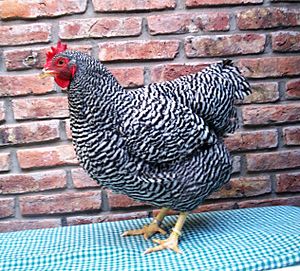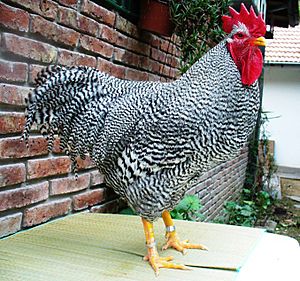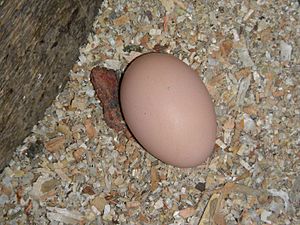Plymouth Rock chicken facts for kids

Plymouth Rock Hen, Barred plumage
|
|
| Conservation status | Recovering |
|---|---|
| Other names | Rock Barred Rock |
| Country of origin | United States |
| Standard |
|
| Use | Dual-purpose breed |
| Traits | |
| Weight |
|
| Skin color | Yellow |
| Egg color | Brown |
| Comb type | Single |
| Classification | |
| APA | American |
| ABA | Single comb clean legged |
| EE | yes |
| PCGB | Soft feather: heavy |
| APS | heavy breed softfeather |
|
|
The Plymouth Rock is a popular American chicken breed. It first appeared in Massachusetts in the 1800s. For a long time, it was the most common chicken in the United States. These chickens are good for two things: their meat and their brown eggs. They can handle cold weather well. They are also easy to care for and are good at sitting on their eggs to hatch them.
Contents
History of the Plymouth Rock
The Plymouth Rock chicken was first shown in Boston in 1849. After that, it wasn't seen for about twenty years.
How the Breed Started
In 1869, in Worcester, Massachusetts, a person named D.A. Upham created new chickens. He cross-bred (mixed) some Black Java hens with a rooster. This rooster had a special striped pattern on its feathers, called "barred plumage." It also had a single comb on its head.
Upham then selectively bred these chickens. This means he chose only the chickens with barred feathers and clean (no feathers) legs to have babies. The Plymouth Rock chickens we see today are thought to come from these birds. Other chicken breeds, like the Brahma and the Cochin, also helped create the Plymouth Rock.
Becoming a Popular Breed
The Plymouth Rock was officially added to the American Poultry Association's list in 1874. The barred feather pattern was the first one recognized. Later, other colors were added to the breed.
The Plymouth Rock became very popular in the United States. This was because it had many good qualities. Its meat tasted good, and it laid many eggs. It could also handle cold weather. These chickens grew feathers quickly and were easy to manage. They were also good at sitting on their eggs. Because of these reasons, the Plymouth Rock was the most common chicken breed in the U.S. until World War II.
Modern Day Plymouth Rock
After World War II, large chicken farms became more common. The Plymouth Rock was used a lot to create new types of chickens called broilers. Broilers are chickens raised quickly for meat. Because of this, the Plymouth Rock became less popular as a regular farm chicken.
Today, the Plymouth Rock is listed as "recovering" by the Livestock Conservancy. This means its numbers are growing again. There are thousands of Plymouth Rock chickens around the world. The White Plymouth Rock is especially common.
Characteristics of Plymouth Rock Chickens
The Plymouth Rock chicken has a single comb on its head. This comb has five points. Its wattles (fleshy growths under the beak) and ear-lobes are bright red. Their legs are yellow and do not have feathers. Their beak can be yellow or horn-colored. They have a long, wide back and a fairly deep chest.
Color Varieties
In the United States, there are seven recognized color patterns for the Plymouth Rock. These include:
- Barred (striped)
- Blue
- Buff (light orange-brown)
- Columbian
- Partridge
- Silver-penciled
- White
Other countries also recognize different colors. For example, in Australia, the barred type is split into two separate colors: dark barred and light barred.
Uses of Plymouth Rock Chickens
The Plymouth Rock is a "dual-purpose" breed. This means it is raised for two main reasons: its meat and its eggs. These chickens lay about 200 large brown eggs each year.
Industrial Use
White Plymouth Rock chickens are often used in large farms for producing eggs and meat. This is because they have been specially bred to lay more eggs and grow more meat. They are also calm and tough, which makes them easy to raise in large numbers.
White Plymouth Rocks are often crossed with Cornish chickens. This mix creates the type of chicken you often see in grocery stores for meat.
Images for kids




